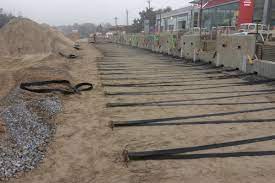RS walls, also known as reinforced soil walls, are innovative structures that provide stability and strength while offering cost-effective and sustainable solutions for various construction projects. This blog post will explore the intricacies of RS wall, answering key questions and providing valuable insights into their construction and benefits.
Understanding RS Walls:
RS wall are engineered structures that combine soil and reinforcing elements to create a stable and efficient retaining wall system. Here are some important aspects to consider:
What are the components of an RS wall?
An RS wall consists of three main components:
Backfill Soil: The backfill soil provides the primary resistance against earth pressures and is compacted in horizontal layers.
Reinforcement: High-strength geosynthetic materials, such as geogrids or geotextiles, are embedded within the backfill soil to enhance its tensile strength and prevent sliding.
Facing: The facing, often made of concrete panels or blocks, provides aesthetic appeal and additional stability to the wall system.
How are RS walls constructed?
The construction of RS wall involves the following steps:
Site Preparation: The construction site cleared, excavated, and leveled to prepare the foundation for the RS wall.
Backfill Placement: The backfill soil placed in layers and compacted to the desired density. Each layer is carefully check to ensure uniform compaction.
Reinforcement Installation: The geosynthetic reinforcement placed within the backfill soil at specific intervals, ensuring proper connection to the facing.
Facing Installation: The facing elements, such as concrete panels or blocks, installed to create a visually appealing and stable wall surface.
Wall Compaction and Finishing: The entire RS wall compacted to ensure proper settlement and stability. Final finishing touches, such as waterproofing or drainage systems, are add as required.
What are the advantages of RS walls?
RS walls offer several advantages:
Cost-effective: RS wall are often more economical than traditional retaining walls, as they require less excavation and utilize locally available soil.
Flexibility: RS wall are highly versatile and adaptable, allowing for construction in diverse shapes, heights, and configurations, thus making them ideal for a wide array of applications.
Durability: The combination of reinforcing elements and well-compacted soil makes RS walls highly resistant to external forces, ensuring long-term stability.
Environmental Sustainability: RS wall use natural soil and can incorporate recycled materials. Reducing the carbon footprint and promoting sustainable construction practices.
Conclusion:
RS walls provide an effective and sustainable solution for stabilizing slopes, retaining soil, and creating aesthetically pleasing structures. By utilizing geosynthetic reinforcement and proper construction techniques, RS walls offer numerous advantages over traditional retaining walls. Their cost-effectiveness, durability, and flexibility make RS wall a preferred choice for a wide range of construction projects. Contributing to safer and more sustainable infrastructure development.

